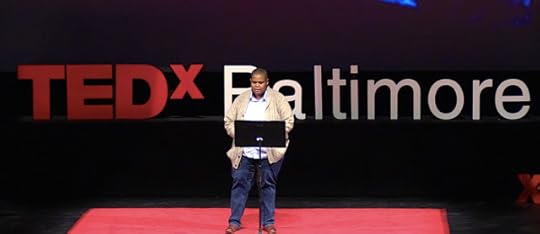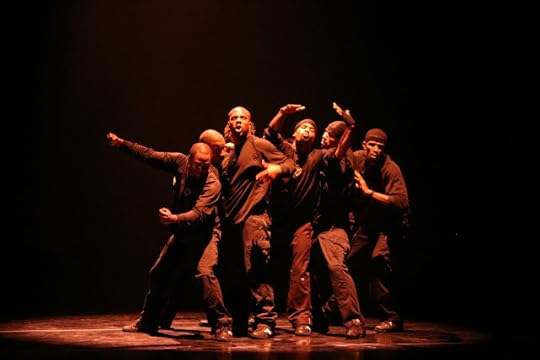Mark Anthony Neal's Blog, page 642
February 17, 2016
From #BlackLivesMatter to Black Liberation: Keeanga-Yamahtta Taylor @ TEDxBaltimore
 '150 Years to the day following the unconditional Confederate surrender to the Union Army, Freddie Gray was arrested in Baltimore and severely beaten. His subsequent death, and that of other African Americans at the hand of police, exposed the factual chasm between formal equality before the law and actual self-determination and self possession inherent to actual freedom.Keeanga-Yamahtta Taylor is an Assistant Professor at the Center for African American Studies at Princeton University and the author of
From #BlackLivesMatter to Black Liberation
.'
'150 Years to the day following the unconditional Confederate surrender to the Union Army, Freddie Gray was arrested in Baltimore and severely beaten. His subsequent death, and that of other African Americans at the hand of police, exposed the factual chasm between formal equality before the law and actual self-determination and self possession inherent to actual freedom.Keeanga-Yamahtta Taylor is an Assistant Professor at the Center for African American Studies at Princeton University and the author of
From #BlackLivesMatter to Black Liberation
.'
Published on February 17, 2016 19:13
Left of Black S6:E18: #BlackMovementMatters: Dance, Hip-Hop + Social Justice
 Left of Black S6:E18: #BlackMovementMatters: Dance, Hip-Hop + Social Justice
Left of Black S6:E18: #BlackMovementMatters: Dance, Hip-Hop + Social JusticeTo coincide with the residency of choreographer Rennie Harris at Duke University, The John Hope Franklin Center hosted a panel discussion featuring Harris, Duke University Professor, Curator, and Dance Historian Thomas DeFrantz and members of Rennie Harris Puremovement. The discussion was moderated by Left of Black host Mark Anthony Neal. Left of Black is a weekly Webcast hosted by Mark Anthony Neal and produced in collaboration with the John Hope Franklin Center at Duke University and in conjunction with the Center for Arts, Digital Culture & Entrepreneurship (CADCE).
***
Episodes of Left of Black are also available for free download in @ iTunes U
***
Follow Left of Black on Twitter: @LeftofBlack
Published on February 17, 2016 06:04
February 15, 2016
Kimberlé Crenshaw: Justice Scalia "Bludgeoned" the Constitution That Gave Us Desegregation, Women's Rights
 "We talk about the legacy of Supreme Court Justice Antonin Scalia, the leading conservative voice on the Supreme Court for decades. "What’s not really being said as much as it should be is just how devastating his legacy is," says Kimberlé Crenshaw, law professor at UCLA and Columbia University. "Justice Scalia was a person who effectively bludgeoned the life out of the living Constitution, the Constitution that gave us desegregation, that gave us women’s rights, that gave us environmental protections and political access." -- +Democracy Now!
"We talk about the legacy of Supreme Court Justice Antonin Scalia, the leading conservative voice on the Supreme Court for decades. "What’s not really being said as much as it should be is just how devastating his legacy is," says Kimberlé Crenshaw, law professor at UCLA and Columbia University. "Justice Scalia was a person who effectively bludgeoned the life out of the living Constitution, the Constitution that gave us desegregation, that gave us women’s rights, that gave us environmental protections and political access." -- +Democracy Now!
Published on February 15, 2016 21:26
Talking "Hip-Hop Dance" with Choreographer Rennie Harris
 On this episode of
Left of Black on The Root
, choreographer Rennie Harris of Rennie Harris PureMovement discusses the challengesof representing the authenticity of Hip-Hop Dance. Harris's comments were part of a panel discussion #BlackMovementMatters: Dance, Hip-Hop + Social Justice held at the
John Hope Franklin Center for Interdisciplinary and International Studies
at Duke University.
On this episode of
Left of Black on The Root
, choreographer Rennie Harris of Rennie Harris PureMovement discusses the challengesof representing the authenticity of Hip-Hop Dance. Harris's comments were part of a panel discussion #BlackMovementMatters: Dance, Hip-Hop + Social Justice held at the
John Hope Franklin Center for Interdisciplinary and International Studies
at Duke University.
Published on February 15, 2016 20:16
Duke University Hip-Hop Cinema Film Series--February 17-18
Published on February 15, 2016 19:43
"All About Love": NewBlackMan (in Exile) Celebrates the Life & Music of Maurice White
 Maurice White, musician and founder of the influential collective Earth, Wind & Fire, transitioned on February 4, 2016. Recognizing the ways that even very popular Black artists are given short shrift in mainstream accounts of their lives and artistic merit,
NewBlackMan (in Exile)
offers a tribute to the life and music of Maurice White featuring contributions from
I. Augustus Durham
+
Charles L. Hughes
+ Emily J. Lordi + Law Ware +
NewBlackMan (in Exile)
managing editor Mark Anthony Neal.
Maurice White, musician and founder of the influential collective Earth, Wind & Fire, transitioned on February 4, 2016. Recognizing the ways that even very popular Black artists are given short shrift in mainstream accounts of their lives and artistic merit,
NewBlackMan (in Exile)
offers a tribute to the life and music of Maurice White featuring contributions from
I. Augustus Durham
+
Charles L. Hughes
+ Emily J. Lordi + Law Ware +
NewBlackMan (in Exile)
managing editor Mark Anthony Neal. Mr. White! *said in echo*: Charting the Black(ness)by I. Augustus Durham | @imeanswhatisays | NewBlackMan (in Exile) +++ Maurice White...of Memphis, Tennesseeby Charles L. Hughes | @CharlesLHughes2 | NewBlackMan (in exile) +++ The Way of the World: A Tribute to Maurice Whiteby Emily J. Lordi | @EJLordi | NewBlackMan (in Exile) +++
The Earth, Wind, and Fire...This Time: In Appreciation of Maurice Whiteby Law Ware | @Law_Ware | NewBlackMan (in Exile) +++ Radio Days + Blue Light Nights + the Legacy of Maurice Whiteby Mark Anthony Neal | @NewBlackMan | NewBlackMan (in Exile)
Published on February 15, 2016 19:05
The Power of Black Women and Style
 On this episode of
Left of Black on The Root
, host Mark Anthony Neal talks with Tanisha C. Ford about the inspriation for her new book,
Liberated Threads: Black Women, Style, and the Global Politics of Soul
(University of North Carolina Press, 2015). Ford is an Assistant Professor of Women, Gender and Sexuality Studies at the University of Massachusetts Amherst.
On this episode of
Left of Black on The Root
, host Mark Anthony Neal talks with Tanisha C. Ford about the inspriation for her new book,
Liberated Threads: Black Women, Style, and the Global Politics of Soul
(University of North Carolina Press, 2015). Ford is an Assistant Professor of Women, Gender and Sexuality Studies at the University of Massachusetts Amherst.
Published on February 15, 2016 08:44
February 14, 2016
The Impact Of "Broken Windows" Policing On Black Communities
 Profile of activists and organizers in New York who are addressong "Broken Windows" policing in largely Black and Latinx communities. -- +Elite Daily
Profile of activists and organizers in New York who are addressong "Broken Windows" policing in largely Black and Latinx communities. -- +Elite Daily
Published on February 14, 2016 20:46
Professor Martha Jones: On Birthright Citizens--A History of Race & Rights in Antebellum America
 'University of Michigan Professor Martha S. Jones offers insight on her upcoming book, Birthright Citizens: A History of Race and Rights in Antebellum America, which explores the activism of free African Americans in the period before the U.S. Civil War and the impact that their argument for birthright citizenship had on passage of the Fourteenth Amendment. The book is due out in 2016. Jones is a member of the Law School's Affiliated LS&A Faculty and codirector of the Michigan Law Program in Race, Law & History. She is also an associate professor of history and associate chair of U-M's Department of Afroamerican and African Studies.'
'University of Michigan Professor Martha S. Jones offers insight on her upcoming book, Birthright Citizens: A History of Race and Rights in Antebellum America, which explores the activism of free African Americans in the period before the U.S. Civil War and the impact that their argument for birthright citizenship had on passage of the Fourteenth Amendment. The book is due out in 2016. Jones is a member of the Law School's Affiliated LS&A Faculty and codirector of the Michigan Law Program in Race, Law & History. She is also an associate professor of history and associate chair of U-M's Department of Afroamerican and African Studies.'
Published on February 14, 2016 20:29
Radio Days + Blue Light Nights + the Legacy of Maurice White by Mark Anthony Neal
 Radio Days + Blue Light Nights + the Legacy of Maurice Whiteby Mark Anthony Neal | @NewBlackMan | NewBlackMan (in Exile)
Radio Days + Blue Light Nights + the Legacy of Maurice Whiteby Mark Anthony Neal | @NewBlackMan | NewBlackMan (in Exile)“I hear voices, I see people…talking ‘bout everything is everything” and though the lyrics aren’t from the late Maurice White, co-written instead by fellow Chess Records alum Phillip Upchurch, and first recorded by the late Donny Hathaway, this line from Earth, Wind & Fire’s second album The Need of Love (1971) says everything about about the music of Earth, Wind and Fire and its longtime conjuror.
“Everything is Everything” is from the fledgling Earth, Wind and Fire’s time with Warner Brothers. The music, which shared wide open spaces with that of early Funkadelic, the Isley Brothers of the early T-Neck era (both before and after the 3+3 formation), and the trio incarnation of LaBelle, could only be called experimental if you didn’t know the archive that they all were drawing from--dripping with the radical possibilities of the abstract as a means of futuring Blackness, cause as Margo Crawford might say, what else was the Black Arts Movement about?
Yet the bohemian funk that grounded those first two Earth, Wind and Fire albums—and like the aforementioned work of Funkadelic, the Brothers Isley and Labelle, an index of musical Blackness in transition—White jettisoned that formation, choosing instead a new label, and a new brand (perhaps), under the helm (for a very short time) of an industry Godfather, who was developing a certain talent for transitioning the Bold the Black and the Brown, into usable commodity. In Earth, Wind & Fire, Clive Davis, perhaps had the inroads to the Black radio audiences he sought, something never intended for say Miles Davis and Carlos Santana, and lost with the demise of that classic Sly & the Family Stone sound.
No doubt Clive Davis was hedging his bets with the unproven Earth Wind and Fire; as he was buying out the group’s contract for CBS, he was also plotting to provide seed money to an entity coming out of Philadelphia that would establish itself as the definitive Black music brand of the 1970s. Davis was no longer at CBS records when the music of Earth, Wind and Fire and Philadelphia International Records (The O’jays + Harold Melvin & The Bluenotes + Teddy Pendergrass + Lou Rawls) both became the Sound of the 1970s; it bears reminding though that well before Davis revitalized the career of Aretha Franklin and shepherded the career of Whitney Houston, that one of his first signings at Arista Records was Gil Scott-Heron.
For White, the decision to move to Columbia and the possibility of mass appeal, may have had a lot to do with his time growing up in South Memphis and playing drums in the Ramsey Lewis Trio. As Jazz titans debated the merits of keeping the hard bop, boppable, or freeing it to fly, Ramsey Lewis kept it in the pocket and toe-tapping accessible, and you couldn’t say after hearing “The In Crowd” for the 77th time, that his band didn’t have chops. Hell even Lewis’s sidemen—Drummer Isaac "Red" Holt and bassist Eldee Young,—ruled a summer with the instrumental “Soulful Strut” (1969).
Listen to any of those first Earth, Wind & Fire albums, including Last Days and Time (1972), Keep Your Head to the Sky (1973) and their commercial breakthrough Open Our Eyes (1974), and what is clear is that White and Earth, Wind and Fire had something to say—about spirituality, community, love, AfroFuture continuums—and to White’s credit, he wanted to reach the widest audience possible.
Songs like “That’s the Way of the World,” “September,” “Sing a Song,” “Shining Star,” “After the Love is Gone,” and “Boogie Wonderland” are as quintessentially 1970s Pop as anything produced by Chicago, The Eagles and Elton John--more accessible than most of David Bowie’s or Fleetwood Mac’s catalogue from that period.
Yet the sustainability of Earth, Wind and Fire was the duality of a group that back-channelled Black uplift for audiences bereft of Black decoder rings, while making sure that the band remained committed to Album Oriented Soul, cause folks needed more than the hits to survive--needed to have a little something to claim for themselves.
Show me a Black-Over-Age-40 Earth, Wind and Fire fan, and they riffing about “Devotion,” “Keep Your Head to the Sky,” “Fantasy”--from arguably the band’s most complete album statement All n’ All--“Wanna Be with You,” “Side by Side” or the collaboration with Ramsey Lewis on “Sun Goddess,” which gave the late pianist his biggest hit since “The In Crowd.”
And not leaving anything to chance, Earth, Wind & Fire always had a little something for when the Blue Light came on. Everybody will cite “Reasons”-- especially the live version from Gratitude where vocalist Philip Bailey and late saxophonist Don Myricks engage in a form of call-and-response that competes with the best we’ve heard on any Sunday morning--but there are so many others: “Can’t Hide Love,” “Lover’s Holiday,” “All About Love,” and a personal favorite “Be Ever Wonderful.”
True that Earth, Wind & Fire’s ability to craft pop hits, along-side B-side album grooves and timeless drags was matched by them Philly boys, Gamble and Huff, but where Philadelphia International needed a cast of many, including lesser knowns like Bunny Sigler, Dee Sharp Gamble, The Three Degrees, MFSB (PIR’s backing band), and The Jones Girls to articulate their musical vision, Earth, Wind & Fire matched that productivity in one self-contained band, and of course the Phenix Horns (led my Myrick).
White, though, could also claim his impact on artists like The Emotions, whose breakthrough release Rejoice (1977), with the still timeless “Best of My Love” (written with EWF’s Al Mckay), was produced by White, as well as Deniece Williams’ debut This is Niecy (1976), which includes the classic “Free” and the brilliant “If You Don’t Believe.” White also produced Jennifer Holiday’s debut Feel My Soul (1983), three Ramsey Lewis albums, and much later in his career, two albums for the Jazz supergroup, Urban Knights (with Grover Washington, Omar Hakim, and others). In the mid-1980s, as Earth, Wind and Fire took a four year hiatus, White released his eponymously titled solo album, led by a cover of Ben E. King’s “Stand by Me” and the gentle-stepper “I Need You.” In that era, he also contributed production to 1970s pop-chart peers Neil Diamond and Barbra Streisand.
Earth, Wind and Fire, and Maurice White in particular, will likely never get deserved recognition for its success during the band’s heyday of 1974-1982, and perhaps that is as it should be. The Phoenix rises again, and importantly, the right folk will recognize it when they see...and hear it.
+++
Mark Anthony Neal is Professor of African + African American Studies and Professor of English at Duke University, where he is also directs the Center for Arts + Digital Culture and Entrepreneurship and hosts the weekly video podcast Left of Black. Follow him on Twitter at @NewBlackMan.
Published on February 14, 2016 19:08
Mark Anthony Neal's Blog
- Mark Anthony Neal's profile
- 30 followers
Mark Anthony Neal isn't a Goodreads Author
(yet),
but they
do have a blog,
so here are some recent posts imported from
their feed.




